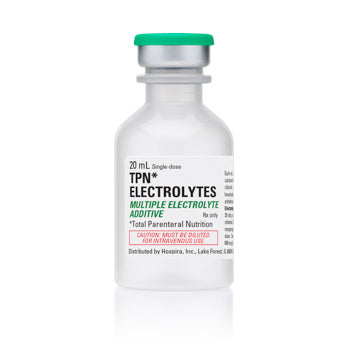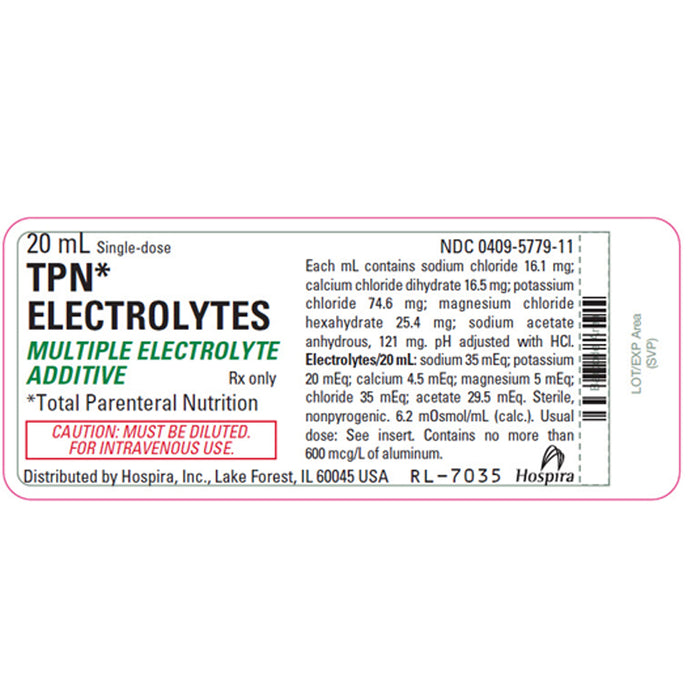TPN Electrolytes (multiple electrolyte additive) Injection 20 mL SDV Vials x 25/Tray (RX)
How to Order:
You will receive instructions on how to create an account along with Rx Ordering Details.
(Note: Acceptable licenses must have Prescriptive Authority in the license issuing state.)
TPN Electrolytes (multiple electrolyte additive) Injection is used in total parenteral nutrition (TPN) to provide essential electrolytes to patients who cannot receive adequate nutrition orally or enterally. This injection helps maintain normal fluid balance, nerve function, muscle function, and acid-base balance by supplying critical electrolytes such as sodium, potassium, calcium, magnesium, chloride, and phosphate. Administered under medical supervision, TPN Electrolytes are crucial for individuals with severe malnutrition, gastrointestinal issues, or conditions requiring complete bowel rest. Proper dosing and monitoring are essential to prevent imbalances or complications.
Enhance your parenteral nutrition regimen with Pfizer Injectables' TPN Electrolytes (Multiple Electrolyte Additive), an expertly formulated solution designed to replenish essential electrolyte levels in patients undergoing total parenteral nutrition (TPN). This robust supplement comprises a balance of critical electrolytes necessary for maintaining physiological stability in patients unable to consume adequate nutrients orally. Available in 20 mL single-dose vials, each tray includes 25 vials, ensuring healthcare providers have a consistent supply to meet the dynamic needs of their patients.
Product Details and Features:
Active Ingredients: Each 20 mL vial contains a precise mixture of essential electrolytes, including sodium, potassium, magnesium, calcium, chloride, acetate, and phosphate. This combination is key to maintaining fluid and electrolyte balance.
Packaging: Packaged as 25 single-dose vials per tray, this product supports efficient storage and systematic use within clinical settings.
Indications: Formulated for supplementation in patients receiving TPN, particularly those at risk of electrolyte imbalances.
Manufacturing Excellence: Produced by Pfizer, a leader in pharmaceuticals, ensuring high quality, purity, and reliability in every vial.
Mechanism of Action:
TPN Electrolytes supply indispensable electrolytes vital for numerous cellular functions and systemic physiological processes:
Sodium and Potassium are crucial for maintaining cellular membrane potential and function in nerve impulse transmission and muscle contraction.
Calcium and Magnesium are essential for bone health, neuromuscular function, and enzymatic activity.
Chloride, Acetate, and Phosphate play roles in maintaining acid-base balance, intracellular signaling, and energy transfer.
Note: This formulation ensures that patients with compromised nutritional intake have the necessary electrolytes to support metabolic processes, systemic homeostasis, and muscle and nerve functionality.
Warnings:
- Hypersensitivity: Do not administer to patients who have shown hypersensitivity to any of its components.
-
Electrolyte Overload: Patients with renal impairment, cardiac issues, or electrolyte imbalances require careful monitoring and individual dosing adjustments to avoid the risk of fluid or electrolyte overload.
-
Interactions: Use caution when administering alongside other medications that may affect electrolyte balance.
- Pregnancy and Nursing: Use during pregnancy only if the potential benefit justifies potential risks. It should be administered with caution to nursing mothers.
Side Effects:
Common Side Effects: These may include minor local reactions at the site of infusion, such as irritation or discomfort.
Serious Side Effects:
An electrolyte imbalance can have serious effects, including:
- Hyperkalemia (high potassium) potentially leading to cardiac issues.
- Hypercalcemia (high calcium) which could result in renal impairment or neurological symptoms.
- Metabolic acidosis or alkalosis depending on the electrolyte in excess or deficit.
Conclusion:
Pfizer's TPN Electrolytes (Multiple Electrolyte Additive) is an integral adjunct for total parenteral nutrition treatments. Its calculated formulation ensures targeted support of electrolyte balance, vital for patient recovery and optimal physiological function. Each vial representing Pfizer's dedication to precision and safety in medical nutrition therapy, making it an indispensable tool for healthcare providers.



